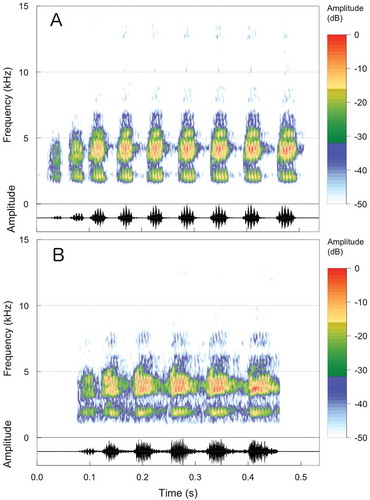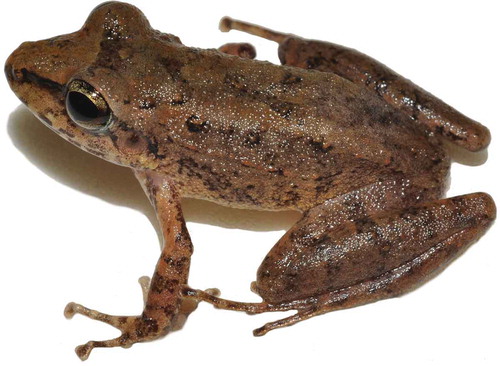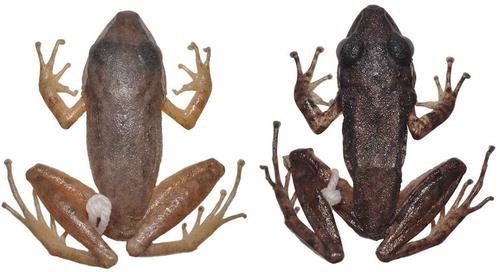ABSTRACT
Two species of Pristimantis are known to exist in the Cerrado Biome, P. dundeei and P. ventrigranulous. Here we report on new localities for P. dundeei that extend its known distribution and present new data on its call and habitat. The new data are from Santo Antônio do Leverger, Barra do Garças and Pontal do Araguaia (MT). Calls were noticeably pulsed to the human ear, with 2–12 similar notes released at a rate of 16–21/s. Calls lasted from 136 to 642 ms, with frequency peaks at 3937–4125 kHz. We found three emphasized frequency bands that were not harmonically related one each other, the second being the dominant one. Males called from a wide range of habitats, from bushes or trees, from open areas or inside forests. Our data from Barra do Garças extend the distribution of P. dundeei up to 380 km to east, which place it in close range to P. ventrigranulous. With regard to characteristics of their call and morphology, these two species cannot be distinguished by any feature. Further studies that consider their genetic distance would be decisive to an eventual synonymization of the two species.
Introduction
Currently, two species of Pristimantis are known to exist in the Cerrado Biome of Central Brazil, P. dundeei (Heyer & Muñoz 1999) and P. ventrigranulosus Maciel, Vaz-Silva, Oliveira & Padial 2012. Both have been placed in the P. conspicillatus group and are phenotypically similar in both call and morphology [Citation1]. Currently, these Pristimantis species are thought to be restricted to their respective type localities [Citation1,Citation2]. Here, we report on a new call record of P. dundeei from around the type locality and in new localities that extends its known distribution within the Cerrado Biome, and, with the aim of improving its taxonomic circumscription, we also provide further data on its advertisement call and habitat.
Figure 3. Audiospectrogram (above) and oscillogram (below) of advertisement calls of Pristimantis dundeei from two localities in the state of Mato Grosso, Brazil. A – St. A. Leverger (18:38 hours, 21°C); B – Barra do Garças (21:46 hours, 25°C). Files corresponding to records St. A. Leverger 1a and Barra do Garças 2c (see Appendix), respectively.

Materials and methods
The new data for P. dundeei ( and ) relate to three localities in the state of Mato Grosso, Brazil: (i) Santo Antônio do Leverger (St. A. Leverger) (15°49ˊ24.05ˊˊS, 55°30ˊ51.67ˊˊW, WGS84 datum, 600 m a.s.l.); (ii) Barra do Garças (ca. 15°51ˊ17.54ˊˊS, 52°15ˊ24.89ˊˊW, Parque Estadual da Serra Azul, between 350 and 550 m a.s.l.) and (iii) Pontal do Araguaia (15°53ˊ1.37ˊˊS, 52°32ˊ21.67ˊˊW, 330 m a.s.l.). Data from St. A. Leverger are especially important because it is located in the Chapada dos Guimarães and close (about 50 km SE) to the type locality of P. dundeei [Citation2].
Fieldwork was carried out at St. A. Leverger on 21 November 2012 and Barra do Garças/Pontal do Araguaia between January 2014 and November 2016. At St. A. Leverger, a male was recorded with a MicroTrack recorder (44.1 kHz, 16 bits) coupled to a Sennheiser K6/ME66 microphone. Regarding Barra do Garças, five males were recorded with a Marantz PMD 671 recorder (44.1 kHz, 24 bits) coupled to a Sennheiser K6/ME67 microphone. Recordings were made between 19:50 hours and 22:00 hours (21–25°C). A calling male was heard in Pontal do Araguaia. Calls were analysed using Raven Pro 1.5 software [Citation3] with the following settings: window type Hann, window size of 512 samples, overlap (locked) of 80%, 3 dB filter bandwidth = 270 Hz, hop size = 2.67 ms, Discrete Fourier Transform (DFT) size = 256 samples and grid spacing = 188 Hz. Temporal traits were measured on oscillograms but also taking into account the spectrograms. The frequency peaks of the dominant, lower and higher emphasized bands were measured. Maximal and minimal energy of a call was evaluated through the frequency 5% and 95% functions of Raven. Sound figures were made using the seewave package v. 1.7.6 [Citation4] in R platform v. 3.3.1 [Citation5], with the following settings: window = Hanning, overlap = 85% and FFT = 256 samples. Call vouchers are in the Museu de Biodiversidade do Cerrado, Universidade Federal de Uberlândia (MG, Brazil): AAG-UFU 1433 St. A. Leverger and 3506 Barra do Garças.
Results
Calls from St. A. Leverger ( above) were noticeably pulsed to the human ear, with 9–12 similar notes (heard as pulses) released at a rate of 19 notes/s. Calls lasted from 470 to 642 ms. Three emphasized frequency bands which were not harmonically related one each other were present, the second being the dominant one (4125 kHz). Calls from Barra do Garças ( below) were noticeably pulsed to the human ear, with 2–6 similar notes released at a rate of 16–21 notes/s. Calls lasted from 136 to 314 ms. Three emphasized frequency bands which were not harmonically related one each other were present, the second being the dominant one (3375–3937 kHz). Further details of call traits and comparative data from Heyer and Muñoz (1999) are presented in .
Table 1. Call features of Pristimantis dundeei specimens from around the type locality, Barra do Garças (MT) and from Heyer & Muñoz (1999).
Habitat
In St. A. Leverger, the male called while perched inside a small shaded area composed of herbaceous vegetation and mediumhigh trees, near the margin of an artificial permanent pond. The Barra do Garças specimens (N > 10) called from disturbed open grassy fields (ca. 50 m from the forest border), from forest borders and from inside gallery forests while perched at a height of less than 1.5 m. Males were heard from the base to the top of the hill at Serra Azul. In Pontal do Araguaia, a male was heard calling from a riparian forest.
Additional remarks
Considering the diagnostic features of P. dundeei in relation to P. vetrigranulosus (Pv) listed in Maciel et al. (2012), a comparison with our specimens is as follows ( and ): belly granules absent or poorly defined (defined in Pv); two poorly defined (colour and texture) nuptial pads, one on the thumb and another bordering the outer margin of the inner metacarpal tubercle (single in Pv), dorsal skin coarsely shagreen or shagreen (coarsely shagreen in Pv), a few scattered dorsal flat warts () (absent in Pv), finger fringes weakly developed (weakly developed or absent in Pv) and toe fringes discernible (weakly developed in Pv).
Discussion
Currently, Pristimantis dundeei is only known from its type locality [Citation2], and our data from St. A. Leverger extend its distribution by about 50 km to the southeast within the Chapada dos Guimarães and our new findings in Barra do Garças by up to 380 km to the east, significantly enlarging its known area of distribution within the Cerrado Biome.
Although at the opposite margins of the Araguaia/Garças Rivers, our record to Barra do Garças (vouchered) places P. dundeei in close (about 95 km to Southeast) range to P. ventrigranulous. Major call features of P. ventrigranulosus are [Citation1]: 4.9 notes/call (range 4−7); call duration 289 ms (range 202−411); frequency peak 4021 Hz (range 3452–4335) and note rate 17.1 (range 16–20). Consequently, no call feature distinguishes P. ventrigranulosus from P. dundeei [Citation1,Citation2 and present study]. Our new data from Chapada dos Guimarães added variability in note number and call complexity (multiple emphasized frequency bands) to P. dundeei. The mean values from the Barra do Garças population were quite comparable with those around the type locality.
As seen to call features, the morphological differentiation between Pristimantis dundeei and P. ventrigranulosus is quite poor (e.g. nuptial pads barely discernible; extension of the ventral granulation quite variable), so that the two species cannot be distinguished by any feature. Given these difficulties, further studies addressing an evaluation of their genetic distance, as has already been conducted with other Pristimantis species [Citation6], would be decisive to an eventual synonymization of these two species.
Author contribution
All the authors worked in the field and provided information for the manuscript. Ariovaldo A. Giaretta conducted the call analysis produced photographs and figures and wrote the draft manuscript.
Acknowledgments
Thiago R. Carvalho, Felipe S. Andrade and Izabele Haga helped in the field works. Fernando Pedroni and Maryland Pedroni provide facilities at Barras do Garças. Financial support for works at Serra Azul by MCT/CNPq/MMA/MEC/CAPES/FNDCT (Ação Transversal/FAPs No. 47/2010; Processo CNPq 563134/2010-0). The Bioacoustics Research Program, Cornell Laboratory of Ornithology, provided licenses of Raven Pro. A research grant to AAG by CNPq. Fellowships to BFVT by CNPq. Collection permits by ICMBio/SISBIO (#30059).
Disclosure statement
No potential conflict of interest was reported by the authors.
Additional information
Funding
References
- Maciel NM, Vaz-Silva W, Oliveir D, et al. A new species of Pristimantis (Anura: strabomantidae) from the Brazilian Cerrado. Zootaxa. 2012;3265:43–56.
- Heyer WR, Muñoz AM. Validation of Eleutherodactylus crepitans Bokermann, 1965, notes on the types and type locality of Telatrema heterodactylum Miranda-Ribeiro, 1937, and description of a new species of Eleutherodactylus From Mato Grosso, Brazil (Amphibia: anura: leptodactylidae). Proc Biol Soc Wash. 1999;112(1):1–18.
- Bioacoustics Research Program. Raven Pro: interactive sound analysis software (version 1.5). Ithaca, NY: The Cornell Lab of Ornithology; 2012. [cited 2016 Dec 17]. Available from http://www.birds.cornell.edu/brp/raven/RavenOverview.html
- Sueur J, Aubin T, Simonis C. Seewave, a free modular tool for sound analysis and synthesis. Bioacoustics. 2008;18:213–226.
- R Core Team. R: A language and environment for statistical computing (version 3.3.1). Vienna, Austria: R Foundation for Statistical Computing; 2016. [cited 2016 Dec 17]. Available from http://www.R-project.org
- Padial JM, De la Riva I. Integrative taxonomy reveals cryptic Amazonian species of Pristimantis (Anura). Zool J Linn Soc. 2009;97–122.
Appendix: Examined material
Call recordings from the A. A. Giaretta record files:
Pristimantis_dundeeiStAntLevergerMT1aBFVT_AAGmt.wav
Pristimantis_dundeeiBGarcasMT1aCSB_AAGm671.wav
Pristimantis_dundeeiBGarcasMT1bCSB_AAGm671.wav
Pristimantis_dundeeiBGarcasMT2aAAGm671.wav
Pristimantis_dundeeiBGarcasMT2bAAGm671.wav
Pristimantis_dundeeiBGarcasMT2cAAGm671.wav
Pristimantis_dundeeiBGarcasMT2dAAGm671.wav
Pristimantis_dundeeiBGarcasMT3aAAGm671.wav
Pristimantis_dundeeiBGarcasMT3bAAGm671.wav
Pristimantis_dundeeiBGarcasMT4aAAGm671.wav
Pristimantis_dundeeiBGarcasMT5aAAGm671.wav
Pristimantis_dundeeiBGarcasMT5bAAGm671.wav
Pristimantis_dundeeiBGarcasMT5cPM_AAGm.wav
Pristimantis_dundeeiBGarcasMT6aAAGm671.wav
Pristimantis_dundeeiBGarcasMT6bAAGm671.wav


